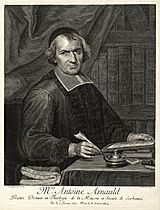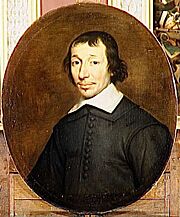Antoine Le Maistre facts for kids
Antoine Le Maistre (born May 2, 1608 – died November 4, 1658) was a French lawyer, writer, and translator. He was also connected to a religious movement called Jansenism. You might also see his name spelled as Lemaistre or Le Maître. Sometimes, he used the pen name Lamy.
Antoine Le Maistre's Family and Early Life
Antoine Le Maistre was the son of Isaac Le Maistre, a king's advisor. His mother, Catherine Arnauld, came from a well-known family of lawyers. Her father, Antoine Arnauld (1560–1619), was a famous lawyer too. The Arnauld family came from a region in France called the Auvergne. They moved to Paris in the 1500s.
Antoine's grandfather, the lawyer Antoine Arnauld, was famous for defending the University of Paris. He spoke strongly against the Jesuits in 1594. This defense was so powerful that people called it "the original sin of the Arnaulds."
Antoine's grandmother, Catherine Marion de Druy, had twenty children. Ten of them died young. Most of their ten surviving children became involved with the Port-Royal des Champs abbey. This abbey was a center for the Jansenist religious movement.
Many of Antoine's relatives were important figures at Port-Royal. His uncle, Antoine Arnauld (1612–1694), was a leading religious thinker of his time. He was known as "the Great Arnauld." His aunt, Jacqueline-Marie-Angélique Arnauld, became the abbess (leader) of Port-Royal. She made it a very important place for Jansenism. Another aunt, Jeanne-Catherine-Agnès Arnauld, also became an abbess there. His uncle, Henri Arnauld (1597–1692), became a bishop.
When Antoine was seven, he moved in with his grandfather Antoine Arnauld. He grew up in his grandfather's home. He was encouraged to become a lawyer, just like his grandfather. After his grandfather passed away, Antoine also thought about joining the church. But in the end, he trained to be a lawyer.
Antoine Le Maistre's Career and Religious Life

Antoine Le Maistre quickly became a very famous young lawyer. People like Guez de Balzac praised his speeches. They said his powerful words would have made even famous speakers like Cicero and Demosthenes jealous.
However, when he was almost thirty, Antoine made a big decision. During a civil war in France called the Fronde, he decided to leave his law career. He retired to Port-Royal. This decision was influenced by Jean du Vergier de Hauranne, a religious leader. Antoine placed himself under Saint-Cyran's spiritual guidance.
Antoine wrote a letter to his father explaining his choice. He said he felt called by God to leave the world and focus on his faith. He wanted to make up for his sins.
This decision to leave public life made Cardinal Richelieu unhappy. Richelieu did not like losing such a talented lawyer.
In 1638, Antoine and his brother Simon settled at Port-Royal in Paris. Soon, their other brothers, Louis-Isaac, Jean, and Charles, joined them. Later that year, Antoine and some others formed a religious group. They were called les solitaires (the hermits). They lived a simple, strict religious life at Port-Royal des Champs. They followed the teachings of Saint-Cyran. Saint-Cyran even asked the Le Maistre brothers to teach children using his principles.
However, Saint-Cyran was arrested in May 1638. This stopped the solitaires from teaching. Antoine Le Maistre then settled permanently at Port-Royal des Champs in August 1639. He lived a quiet and strict life there. Around 1644, his uncle, Robert Arnauld d'Andilly, joined him. Robert was a poet and translator.

Antoine Le Maistre became friends with the famous writer Jean Racine. Antoine spent his time translating texts and writing about the lives of saints.
He believed that France's freedom came from being a Christian nation. He wrote that "The God of the Christians is the God of liberty." He felt that God had freed people from being servants.
Antoine also helped convince his aunt, Angélique Arnault, to write her life story. She was the abbess of Port-Royal. Her story was mostly about how her community bravely resisted religious challenges.
In 1656, there was a growing movement against Jansenism in France. Antoine Le Maistre went into hiding in Paris. He was with his uncle, Antoine Arnauld, who was on trial for his Jansenist views. The philosopher Blaise Pascal was also with them. Antoine Le Maistre helped Pascal write Lettres provinciales (1656–1657). These were a series of letters defending his uncle.
Antoine Le Maistre passed away on November 4, 1658, after a short illness. He left behind many writings.
His youngest brother was Louis-Isaac Le Maistre de Sacy (1613–1684). He also followed Saint-Cyran's teachings. He became a priest in 1649. He was a confessor (spiritual advisor) to the nuns of Port-Royal and the solitaires. He was highly respected by the Jansenists.
When Antoine Le Maistre died, he had started a new translation of the New Testament. His brother Isaac continued this work and became the main translator. The new translation was published in 1667. It was called Le Nouveau Testament de Nostre Seigneur Jesus Christ: traduit en François selon l'edition Vulgate, avec les differences du Grec. It was printed in Amsterdam for a bookseller in Mons. Because of this, it became known as the Nouveau Testament de Mons, or the Testament of Mons.
Likenesses
A famous painter named Philippe de Champaigne (1602–1674) painted Antoine Le Maistre's portrait. Champaigne was closely connected with Port-Royal des Champs. The original painting is now lost, but a copy still exists. Later, Charles Simonneau made an engraving of this portrait. Champaigne also painted portraits of Antoine's aunts, Angélique Arnauld and Catherine Agnès Arnauld, and his uncle, Robert Arnauld d'Andilly.



